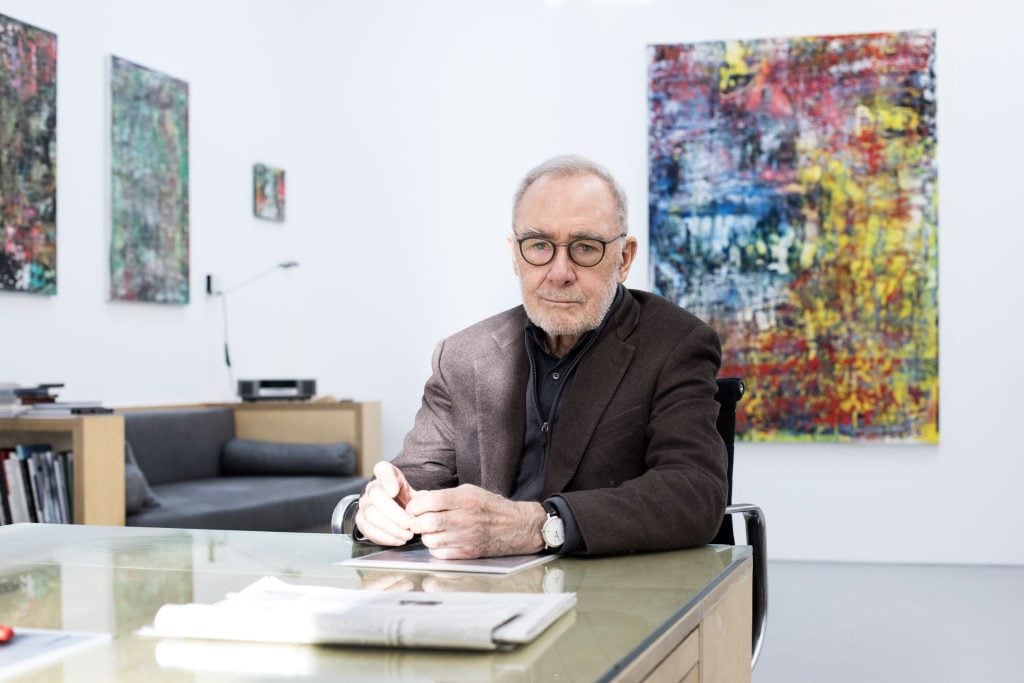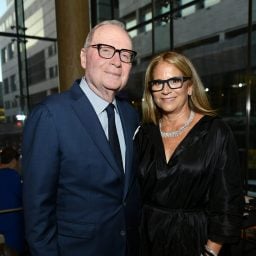Gerhard Richter’s sudden departure from Marian Goodman Gallery after almost four decades sent shockwaves through the art world in December. It was the biggest defection of its kind in recent memory, constituting a dramatic rupture between one of the greatest living artists and the legendary dealer who took him to the pinnacle of curatorial and market acclaim.
The news was announced by David Zwirner Gallery, which gained bragging rights as the new representative of the Promethean artist. The move telegraphed that Richter, just shy of 91 at the time, still had the energy and hunger to do things his way.
But questions swirled. What precipitated such a seemingly abrupt break between Richter and Goodman, two nonagenarians who used to be friends? Was this a betrayal of Shakespearean proportions, or just time marching on? How did David Zwirner, a 58-year-old mega-dealer, accomplish this coup? And what does it all mean for the artist’s market, which generated $225 million at auction last year—besting Rothko and Basquiat and ranking fifth among the more than 400,000 artists tracked by Artnet Price Database.
“It’s a very different proposition, going with David,” said Jean-Paul Engelen, a top executive at Phillips auction house. “If you want to have the last dance, it makes sense.”
Now, suddenly, there’s a lot more Richter buzz than we’ve seen in the past three years, during which the market’s heat shifted from the blue-chip-white-male segment to Black and female artists in the ultra-contemporary bracket.
Next month the Richter action will spill from auction salesrooms in London to David Zwirner’s gallery in New York to Hong Kong, where Art Intelligence Global—an advisory firm co-founded by Amy Cappellazzo—is organizing Richter’s first exhibition in the city, to take place during Art Basel at its exhibition space.
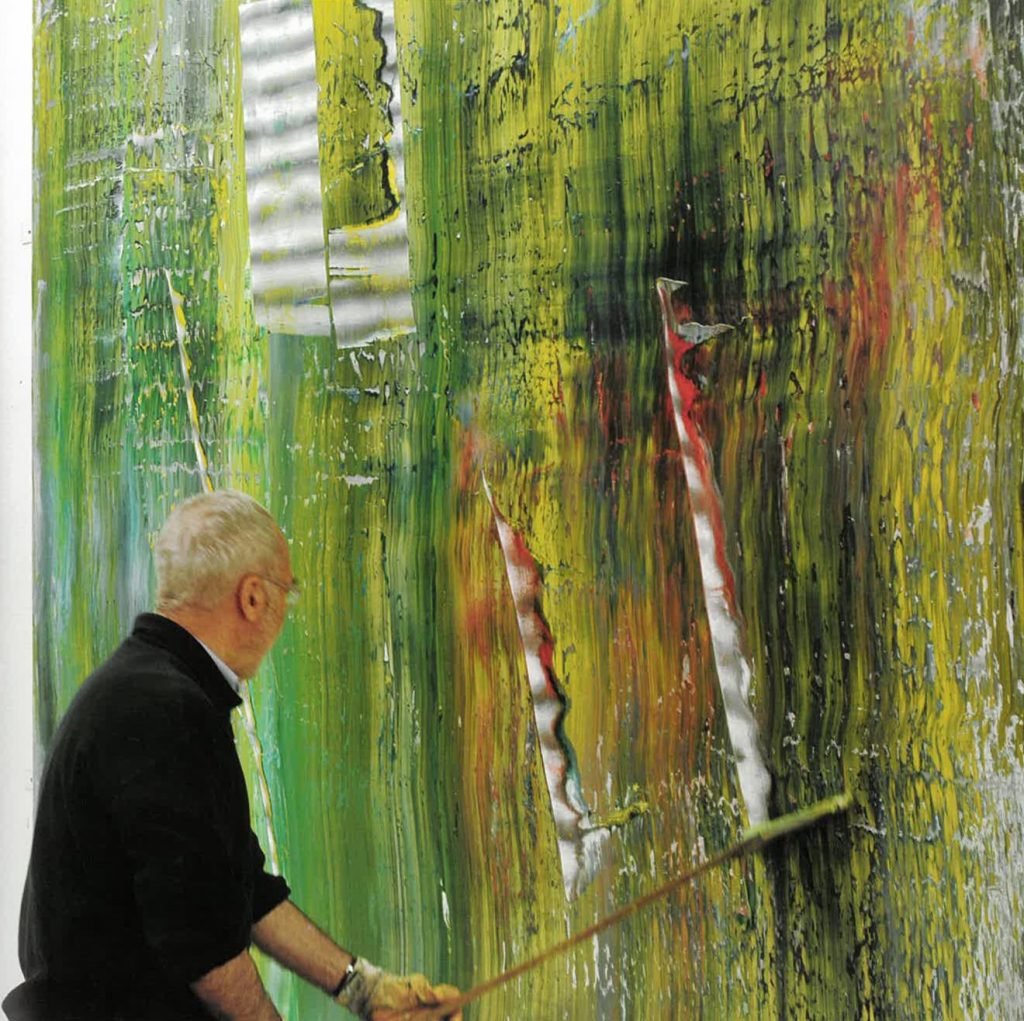
Gerhard Richter working on one of his “Cage” paintings, Cologne, Germany, 2006. Artwork © Gerhard Richter 2020 (05102020) Photo: © Hubert Becker, Courtesy Gagosian.
Richter’s incandescent abstrаctions and somber, grisaille figurative canvases had been among the most sought-after works in the 2010s. Since 2011, not a year has gone by without at least one Richter painting surpassing $20 million at auction, according to Artnet Price Database; in 2014 there were six such lots, as Asia became a big driver of demand. There was a time when every Park Avenue collection of a certain caliber had a Richter prominently displayed. By 2016, Marian Goodman was selling his new large-scale paintings for $5.5 million a pop—and that was just a fraction of auction prices, which reached $46.3 million.
“She really turned him from a German painter who was known in the mid-’80s into a very respected international global player of abstract art,” Philipp Kaiser, president of Marian Goodman Gallery, said in an interview this week. He shied away from using a perhaps more crass but apt term: an art star.
It’s hard to know exactly what caused Richter to part with Goodman. Those who know them say it’s been a long time coming. Goodman hasn’t had the same omnipresence at the gallery of late. She’s spending this winter in Los Angeles. Last month she didn’t come to the opening of Andrea Fraser’s debut at her New York gallery. This week, she appeared at Frieze Los Angeles, looking thinner and smaller in a chic red coat, accompanied by her son.
There was a perception that Goodman, known to be fierce and territorial, wasn’t able to give Richter what he’s come to expect from her over the decades. There were “opportunities not responded to,” according to a person familiar with the gallery, in part due to her reduced presence in the gallery’s day-to-day.
“Marian never wanted to share Gerhard with anyone,” the person said. “Gerhard was her crown jewel.”
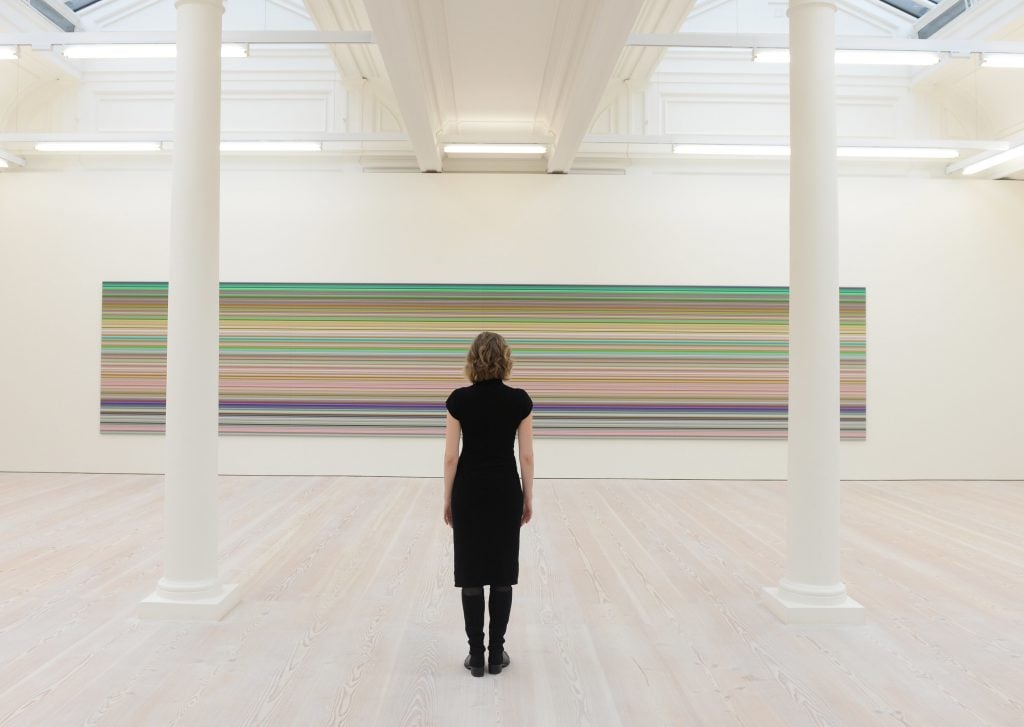
Gerhard Richter exhibition at Marian Goodman Gallery. Photo by rune hellestad/Corbis via Getty Images.
Meanwhile Gagosian gallery had been making a push to win Richter over, offering him representation, staging secondary-market shows in 2019 and 2020, and often featuring him in its publications. Andrew Leslie Heyward, who opened Marian Goodman’s London branch with a Richter show in 2014, now works at Gagosian. Richter’s wife, artist Sabine Moritz, who is also represented by Marian Goodman, was approached to do a show with Gagosian.
“They have tried desperately for years,” Kaiser said. “Whenever I read Gagosian Quarterly, there’s another article on Richter.”
A representative for Gagosian declined to comment.
Kaiser, an international curator who joined Marian Goodman in 2019, said that Richter’s departure had little to do with the matriarch’s lessened involvement in the gallery’s operation.
“He waited as long as possible,” Kaiser said. “But my sense is he wanted to make the decision himself. When it gets closer to your end, you look after yourself. He didn’t want anybody else to make the decision.”
The move is consistent with Richter’s artistic practice. “He’s always been radical,” Kaiser said. “He has this unsentimental side.”
The gallery reorganized in 2021, elevating executive directors to partners and forming an advisory board as it planned for succession. Kaiser, who is Swiss and speaks German, is trusted by Goodman and had a good rapport with Richter.
“I’ve known him for quite a while,” said Kaiser, who served as director of Museum Ludwig in Cologne, where Richter lives, from 2011 to 2013. “I’ve worked with him in the past.”
While art market insiders expected Richter to go to Gagosian, it was the artist himself who reached out to Zwirner. Details were hatched out within weeks.
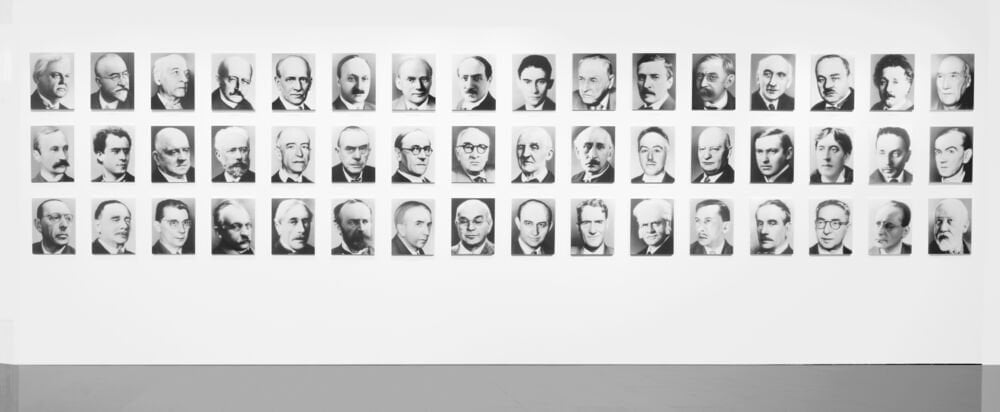
Gerhard Richter, 48 Portraits 1972 (1998). MACBA Collection. MACBA Foundation. © Gerhard Richter.
Richter had known David Zwirner’s father, Rudolf Zwirner, an influential dealer who co-founded the Art Cologne fair, showed Richter at his gallery in the late 1960s, and brokered the sale of his 1972 Venice Biennale project, 48 Portraits, to the Museum Ludwig, said Kaiser.
“We respect David and I think it makes more sense than Gagosian,” Kaiser said. “Gerhard’s work is expensive, but his work is also highly discursive and intellectual.”
Zwirner, in other words, is seen as being on a similar continuum as Marian Goodman. “Gerhard just wants a good custodian for his work,” said a person who knows Richter. “He doesn’t care about the buzz. He’s always felt divorced from the market.”
In recent years, Richter has been more focused on his legacy (and estate planning) than making new work. In May 2020, he established a private art foundation, Gerhard Richter Kunststiftung. Its holdings consisted of 127 artworks, spanning from 1965 to 2019, according to a hardcover catalog published in 2021. The foundation has given permanent loans to several German institutions, including the Richter Archive in Dresden.
(To be sure, that inventory is a tiny fraction of Richter’s famously prolific output; he made 545 abstract paintings in the 1980s alone, according to his online catalog raisonné.)
Meanwhile Richter’s primary market is a shadow of what it once was. In 2017, Richter announced that he would stop painting due to the strenuousness of the process and his advanced age. Since then he has focused on smaller formats and works on paper. His recent group of 31 works titled mood—created by pouring glass paint on paper—were shown last year at the Beyeler Foundation to mark the artist’s 90th birthday.
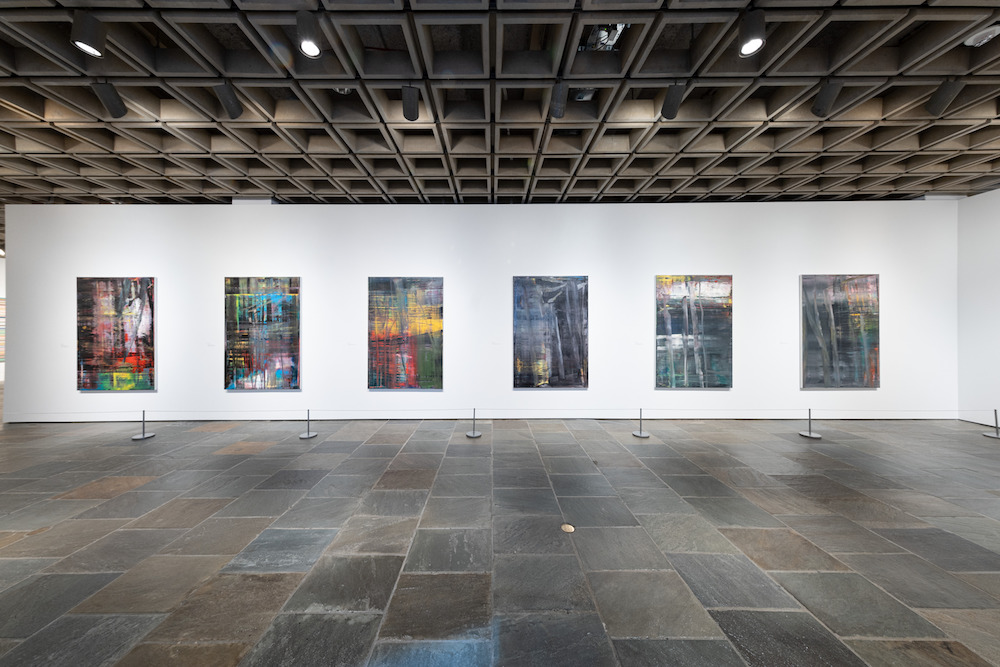
Installation view of “Gerhard Richter, Painting After All” at the Met Breuer, 2020. Courtesy of the Metropolitan Museum of Art. Photo by Chris Heins
The last exhibition of Richter’s new large paintings took place at Marian Goodman in 2020, coinciding with his retrospective at the Metropolitan Museum of Art at the outset of the pandemic. Just five paintings were available for sale, a third of those shown, which were on loan from the foundation.
“He stopped painting, and he makes very few works on paper,” said Kaiser. “There is no basement with works that he owns that can be sold now at a different gallery. The Richter market has moved mostly to the secondary market.”
Richter’s secondary market is robust, if uneven. In 2022, auction sales generated $225 million, ahead of Basquiat’s $221 million and Rothko’s $198.3 million. The auction market peaked at $299 million in 2012, when Richter became the most expensive living artist, but then steadily declined to $102 million in 2020.
Since the pandemic several key works came to the market, including a monumental seascape from the collection of Harry and Linda Macklowe (price: $30.2 million) and an abstract canvas owned by Eric Clapton (price: $36.5 million). Both prices fell within estimates, but didn’t set off any fireworks.
A major event that was poised to cement Richter’s significance—the Met’s retrospective “Gerhard Richter: Painting After All”—opened on March 2, 2020 and closed two weeks later along with the rest of New York City due to COVID-19. Years in the making, the show’s six decades worth of figurative and abstract paintings, glass sculptures, prints, and the hauntingly melancholy Birkenau Cycle (which had a room all to itself) remained largely unseen by the public. Its planned tour to Los Angeles fell apart as well, Kaiser said.
The picture is a lot more upbeat three years on. Richter’s show at Zwirner next month will feature several “last paintings” from 2016 to 2017, works on paper created in 2022 for the Beyeler show, and a glass installation, according to the gallery.
Things are heating up at auction, too. Phillips is offering a Richter abstract consigned by French collector Marcel Brient. Titled Mathis (1983), the early, more gestural abstract canvas will carry an estimate of £10 million to £15 million when it is auctioned in London on March 2.
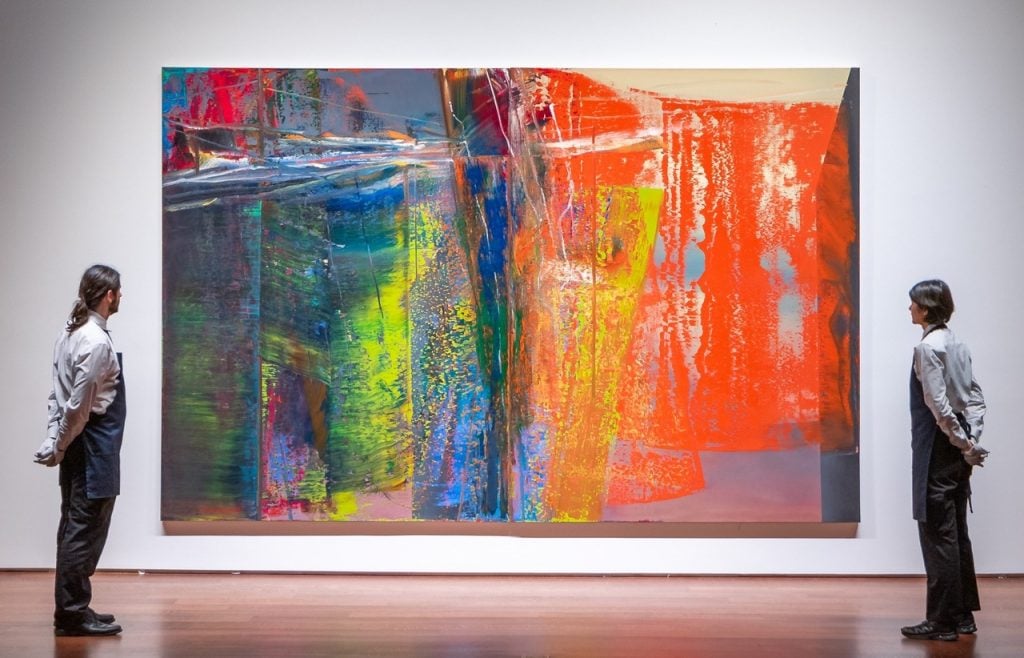
Gerhard Richter, Abstraktes Bild (1986). Courtesy of Sotheby’s.
Sotheby’s scored a 1986 diptych, Abstraktes Bild, spanning 12 feet across and estimated at more than £20 million. It will be offered during the Modern and contemporary evening auction on March 1.
Beyond that, an early figurative painting, Bathers (1967) is expected to headline a not-yet announced collection of Boston philanthropists Sandra and Gerald Feinberg to be offered at auction, likely at Christie’s in May. The blurry, grisaille depicts a group of female nudes. One auction house, which competed for the work, estimated it at $20 million to $30 million, according to a person familiar with negotiations.
Across the globe, Art Intelligence Global’s Richter exhibition during Art Basel Hong Kong will have works available at prices ranging from $1 million to more than $40 million.
Just a couple of highlights in that show have been announced so far. One was consigned by Dallas-based collector Howard Rachofsky. Another, Abstraktes Bild 809-4 (1994), is the same painting that Eric Clapton just sold at auction in May. Reporting on that sale, I noted that Asian interest in high-value lots seemed to have “been switched off with a click.” The only person bidding on the paining was its third-party guarantor, who, presumably, is now sending the canvas to Hong Kong.
Now AIG will test Asian demand again, at the time when Hong Kong is finally opening up after three years of pandemic-related restrictions.
“Last year, COVID restrictions were very harsh and not many people were in the mood for large purchases, unlike years before,” said Yuki Terase, an AIG partner. “I am hoping and do believe that Asian appetite is coming back this year. The mood is definitely better.”
